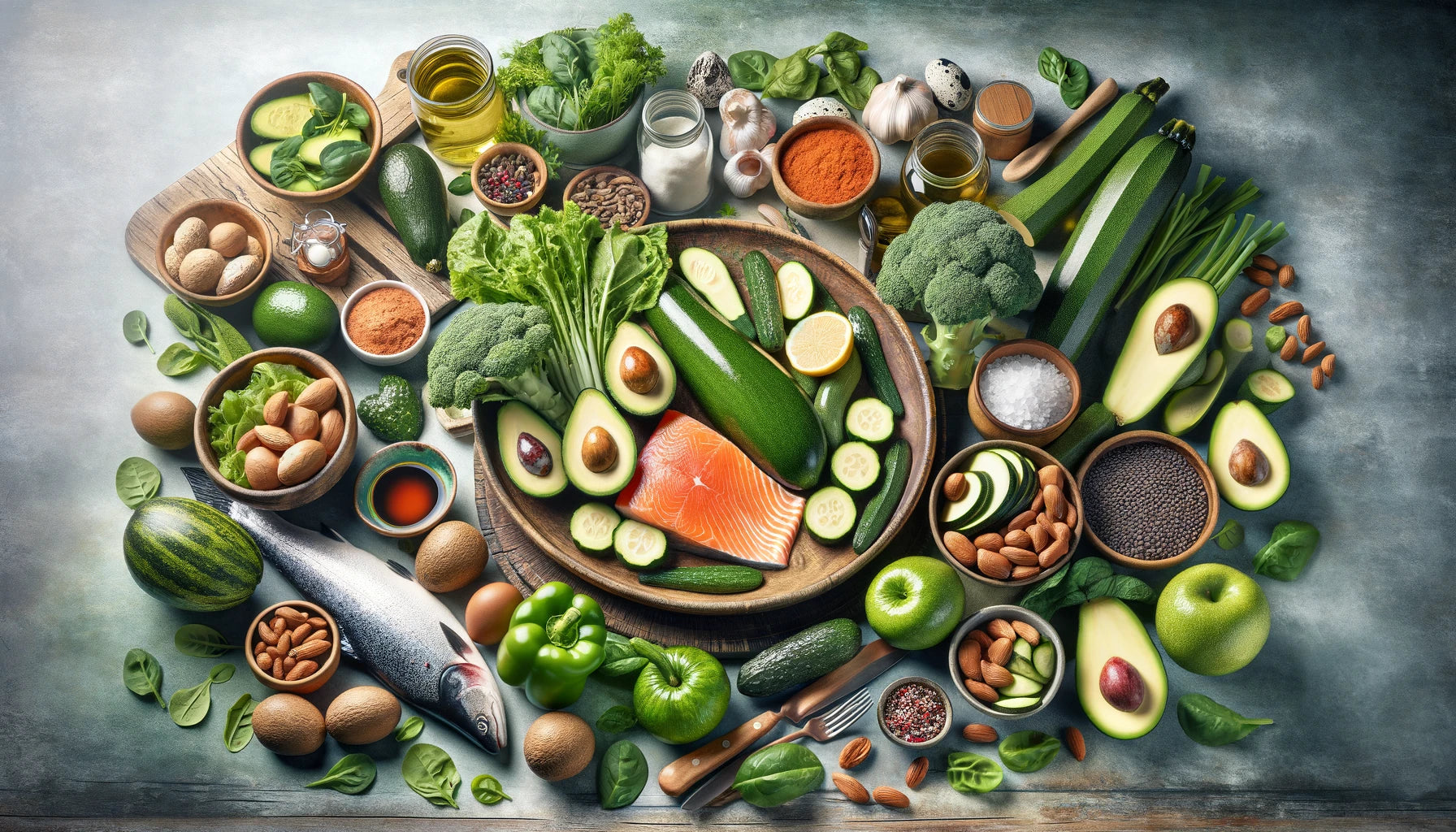Embarking on a ketogenic diet involves more than just cutting back on carbs and increasing fat. To truly reap the benefits of a ketogenic diet, it is important to maintain macronutrient balance as well as micronutrient adequacy. Potassium, an important mineral that supports several bodily functions such as nerve signal transmission and muscle contraction, is particularly important in this regard. The keto diet changes your body’s electrolyte balance, which can make it difficult to maintain adequate potassium levels. This is due to decreased insulin levels and increased diuresis, which can lead to significant electrolyte depletion. Therefore, understanding how to optimize your potassium intake is essential to avoid symptoms such as fatigue, muscle cramps, and even heart palpitations that potassium deficiency can cause.
In this guide, we’ll introduce you to the top 10 potassium-rich ketogenic foods that will help you maintain optimal health and avoid the pitfalls of electrolyte imbalance that are common on a ketogenic diet. From the creamy texture of avocado to the crunch of nuts and seeds, each food offers a delicious and nutritious way to boost potassium levels while meeting your keto goals.
There’s a good reason why avocados are a staple on the ketogenic diet. Not only is it rich in healthy fats that help maintain ketosis, it’s also a good source of potassium. A medium-sized avocado contains about 975 milligrams of potassium, which is about twice as much as a banana, which is traditionally known for its high potassium content.
In addition to potassium, avocados are rich in nutrients, including vitamin K, vitamin E, vitamin C, and B vitamins. It’s also rich in fiber, which helps manage blood sugar levels, makes you feel fuller, and reduces the urge to snack on carbohydrate-rich foods.
Avocados are easy to incorporate into your diet because of their versatility. It can be eaten alone, seasoned with a little salt and pepper, mashed into guacamole, or sliced to top salads or eggs. For a keto-friendly snack, try avocado or tuna salad with half cottage cheese. You can also blend avocado into your smoothie for a nutritious start to your day.
Avocados offer a variety of health benefits beyond their nutritional content. It is rich in monounsaturated fats, which can help lower cholesterol levels and improve heart health. The rich fiber content aids in digestion and also helps prevent constipation, a common problem with ketogenic diets due to the low carbohydrate intake.
Although avocados are very beneficial, they are high in calories, so it is important to consume them in moderation. One avocado provides about 240 calories, mostly from fat, so portion control is important, especially if you’re watching your calorie intake for weight loss.
Leafy vegetables: a treasure trove of nutrients
Leafy greens are some of the most nutritious foods you can have while on a ketogenic diet, and they’re also a good source of potassium. Kale and spinach in particular stand out for their potassium content, which helps meet the daily requirements needed to support key body functions on a low-carbohydrate diet.
Kale and spinach: Learn more
One cup of cooked spinach contains about 839 milligrams of potassium, and the same amount of cooked kale contains about 491 milligrams. These vegetables are not only rich in potassium, but also provide large amounts of vitamins A, C, K, and some B vitamins. Their high fiber content is another benefit, aiding digestion and increasing satiety. This is important for managing hunger while on a keto diet.
More ways to incorporate leafy greens on keto
Incorporating leafy greens into your keto diet is easy and delicious. You can use it as a base for salads, sauté it with garlic and olive oil for a hearty side dish, or add it to smoothies for a nutritional boost without significantly changing the flavor. For a satisfying meal, try the kale salad with avocado, nuts, and lemon-olive oil dressing or the creamy spinach and cheese casserole.
Health Benefits Beyond Potassium
The health benefits of leafy vegetables go beyond their potassium content. It is known for its anti-inflammatory properties thanks to its high levels of antioxidants. These nutrients help protect against chronic disease and support overall health, making leafy greens an important component of any diet, especially a diet like the keto diet.
Remember oxalate
Although spinach is rich in nutrients, it is also high in oxalates, which can contribute to the formation of kidney stones in susceptible people. To reduce risk, moderation is key, as is combining oxalate-rich foods with calcium-rich foods.
Mushrooms: Versatile and rich in potassium
Mushrooms are a great addition to a ketogenic diet, as they are not only low in carbohydrates, but also rich in essential nutrients such as potassium. Different types of mushrooms contain different amounts of potassium, but white mushrooms, for example, contain about 318 milligrams per 100 grams.
Mushroom types and nutritional information
Among the different types of mushrooms, portobello and shiitake are especially popular in keto recipes due to their meaty texture and rich flavor. Portobello mushrooms can be used as a substitute for burger buns or as the base for mini pizzas, and shiitake mushrooms are great in stir-fries and soups. Each type provides significant amounts of potassium and is a good source of vitamins and minerals, such as B vitamins and selenium.
Incorporating mushrooms into the keto diet
Mushrooms can be used in a wide variety of dishes, making them easy to incorporate into any meal. It can be grilled, sautéed, baked, or used in flavorful salads. Try sauteed mushrooms with garlic and herbs as a garnish for a simple and delicious keto meal, or fill a large portobello cap with spinach, cheese, and your protein of choice for a satisfying main course.
health benefits of mushrooms
Besides their potassium content, mushrooms are also known for their immune-boosting properties. These contain antioxidants and compounds that can support immune health and reduce inflammation. Regular consumption of mushrooms is also associated with improved heart health and reduced risk of chronic disease.
Preparing mushrooms on the keto diet
To maximize the health benefits and flavor of mushrooms, it’s best to cook them thoroughly. Cooking not only increases the flavor, but also increases the bioavailability of nutrients, making them even more valuable for a ketogenic lifestyle.

Nuts and seeds on the keto diet: a small but powerful source of potassium
Nuts and seeds are essential to a ketogenic diet, providing healthy fats and protein as well as essential minerals such as potassium. Convenient and versatile, it can be incorporated into any meal or snack, making it ideal for maintaining ketosis while increasing your nutrient intake.
Top Keto-Friendly Nuts and Seeds for Potassium
Almonds: 1 ounce (about 23 almonds) provides 200 milligrams of potassium. Blanched almond flour is recommended for keto baking. Pistachios: One ounce contains 291 milligrams of potassium, the highest of any nut. Pumpkin Seeds: One ounce of pumpkin seeds contains about 226 milligrams of potassium and is also rich in magnesium. Sunflower seeds: Contain about 187 milligrams of potassium per ounce, making them a great snack or salad topping.
Benefits and uses of nuts and seeds on the keto diet
These nuts and seeds not only enrich your diet with potassium, but also contribute large amounts of fiber and protein, which are essential for feeling full and maintaining muscle on a low-carbohydrate diet. It can be enjoyed raw, roasted, or as butter. Nuts and seeds are great in homemade keto granola, as a topping on yogurt or salads, or as an easy energy-boosting snack.
Health Benefits of Nuts and Seeds Beyond Keto
Regular consumption of nuts and seeds is associated with a lower risk of heart disease, certain cancers, and other chronic health conditions. Their anti-inflammatory and antioxidant properties support overall health and well-being.
Careful Intake of Nuts and Seeds on the Keto Diet
Nuts and seeds are beneficial, but they are also high in calories. Portion control is important to avoid accidentally exceeding your daily calorie needs, especially if weight management is your goal with the keto diet.

Other Keto-Friendly Potassium Sources
Avocados, leafy greens, mushrooms, nuts, and seeds are good sources of potassium, but there are other notable foods that can help meet your potassium needs on a ketogenic diet.
salmon and other fatty fish
Fatty fish like salmon not only provide high-quality protein and omega-3 fatty acids, but they’re also a good source of potassium. A typical serving of salmon contains as much as 800 milligrams of potassium, making it perfect for maintaining electrolyte balance on a keto diet.
Zucchini and other pumpkins
Zucchini and other types of squash are low in carbohydrates but rich in potassium. A medium zucchini contains about 500 milligrams of potassium. These vegetables are versatile in the keto kitchen, from zoodles (zucchini noodles) to baked dishes.
broccoli and cauliflower
Both of these vegetables are keto staples because of their low carbohydrate content and high nutrient density. One cup of cooked broccoli contains about 460 milligrams of potassium, and cauliflower has a similar amount. You can roast, steam, or mash them as a low-carb potato alternative.
coconut water on keto diet
For those who want a keto-friendly drink that hydrates and replenishes electrolytes, coconut water can be a good option, but it should be consumed in moderation as it contains natural sugars. It is especially rich in potassium, with 1 cup providing about 600 milligrams.
Conclusion: Managing potassium intake during the keto diet
Ensuring adequate potassium intake on a ketogenic diet is critical to maintaining muscle function, proper cell function, and overall health. Incorporating a variety of these potassium-rich foods into your diet can reduce common side effects of electrolyte imbalances, such as muscle cramps and fatigue. Remember, a balanced keto diet is about more than just macronutrients. Micronutrient balance is equally important for optimal health.






